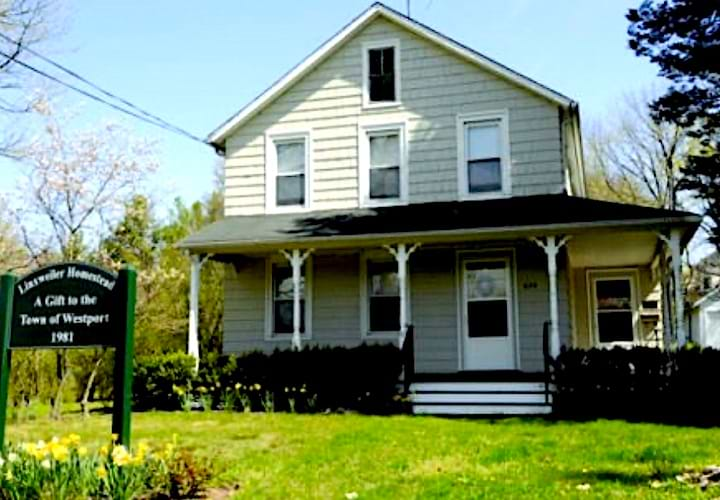
By John Schwing
WESTPORT — Affordable housing was in the public crosshairs for a second day in a row at a Planning and Zoning Committee subcommittee meeting Tuesday, as time runs out on Westport’s moratorium under the state’s 8-30g law and pressure ramps up at the General Assembly for all communities to provide more affordable units.
Both prongs of the thorny issue were discussed at the midday Tuesday meeting of the P&Z’s Affordable Housing Subcommittee, a day after the Representative Town Meeting organized a public forum on the same topic.
Exploring housing options on Linxweiler property …

Addressing implementation of the town’s affordable housing plan, adopted by the P&Z as required by the state last June, Chairwoman Danielle Dobin confirmed the Linxweiler property, at 655 Post Road East, has no deed restrictions that might prevent potential development of affordable units there.
At the subcommittee’s meeting last November, questions arose over whether terms of the 1.3-acre property’s donation to the town by the late Joanna Linxweiler might restrict its development beyond the dwelling that stands on the site. That home is now used as an emergency shelter managed by Homes with Home to house one family.
After consulting with the Town Attorney’s Office, Dobin said no legal impediments stand in the way of developing affordable housing on the site, which she suggested might include a cluster of cottage-like units for people at risk of homelessness.
However, she emphasized the idea currently is only being “explored” as an option to help meet the town’s affordable housing goals, perhaps mindful of the vehement neighborhood opposition that upended a 2010 plan to build supportive housing on the property.
Mathew Mandell, chairman of the Representative Town Meeting’s Planning and Zoning Committee, told the meeting that he continues to investigate ways to establish a local affordable housing trust fund, which could be financed by an additional charge on conveyance or building permit fees.
He is awaiting input from officials in New Canaan and Fairfield, where variations on that concept are already in place.
The Zoom meeting took place under the shadow of the impending expiration of the town’s 8-30g moratorium at week’s end.
Officials warn that, without the moratorium, developers filing multi-unit development plans under the state statute will be able to more easily circumvent local zoning regulations. That’s because less than 10 percent of Westport’s housing inventory meets the state’s affordability criteria, the threshold for a new moratorium.
Desegregate Connecticut’s housing initiative reviewed


The relatively brief discussion of local affordable housing efforts was preceded by a lengthier presentation of a legislative initiative by a statewide housing advocacy group — one of several up for review during the current General Assembly session.
The “Work Live Ride” initiative was detailed by a representative of Desegregate Connecticut, a group described on its website as “a pro-homes coalition of neighbors and nonprofits advocating for better local and state land use policies to make every community in Connecticut more prosperous, equitable and sustainable.”
Tucker Salls, the group’s legislative director, outlined the initiative, currently in draft form, which later will be filed as a bill during the current legislative session.
Salls said the group wants feedback from local zoning officials to help shape the proposal’s final language in an effort to “empower” local planning and zoning commissions’ decisions on housing plans best suited to their respective communities.
The group learned some hard lessons last year when a similar measure — broadly designed to promote affordable housing development close to transportation hubs — was rejected by the legislature, he said.
This year’s revised plan for “Transit Oriented Communities,” Salls said, drops a controversial provision to mandate rules for multi-unit developments, with affordable components, within a half-mile radius of railroad stations.
The revised initiative is designed to restore a more traditional style of mixed-use developments, served by various forms of public transportation, that was typical in New England decades ago before being “bulldozed for cars,” Salls said.
It also has been rewritten to give communities that decide to “opt in” to the Transit Oriented Community program a greater say over how housing projects evolve and more funding to make them possible, he said.
The proposed legislation, however, would penalize communities that decide against opting in, denying them access to “discretionary” funding for things like brownfield cleanups, sewer projects and road/pedestrian safety infrastructure.
Dobin, and other speakers at the meeting, welcomed what they called Desegregate Connecticut’s new attitude toward consulting with local officials and seeking feedback.
However, she cited three major concerns about the group’s new initiative:
- No “special permit” needed from local zoning officials for Transit Oriented Community developments.
The P&Z review process for such permits, Dobin said, has improved housing proposals in Westport, and added the permits have not been used to block multi-unit projects. As evidence, she noted that approximately 650 housing units, with a minimum of 20 percent affordable set-asides, have been approved locally since 2018.
- Requirements for parking facilities would be eliminated for Transit Oriented Community developments.
Dobin said that with the extremely limited public transportation options in Westport, and many other state communities, a housing development that provides no parking for residents would be highly inadequate to meet everyday needs, from work to shopping to lifestyle.
- The proposal’s focus on concentrating Transit Oriented Communities within roughly one-half mile of a transit station.
Dobin suggested, at least in Westport, the town’s Inclusionary Housing Overlay District, which can be applied to much of the Post Road corridor, would be a better option for multi-unit projects. Though most of the lengthy corridor is not within the designated radius of the town’s train stations, its size offers more opportunities for housing development and also is served by an inter-city bus route, she noted.
Several speakers questioned “the metrics” Desegregate Connecticut used to justify the premise of building high-density housing around transit hubs, particularly since the COVID pandemic has transformed work and commuting patterns.
But the proposal to eliminate parking requirements for housing in Transit Oriented Communities sparked the most critical comments.
Jay Walshon suggested it would be “discriminatory” not to provide parking for residents of affordable housing. Restricting car use, he said, besides being impractical is essentially an attempt to impose a lifestyle on people they may not want.
Amanda Sayegh, who works for the Westport Housing Authority, said many residents of the agency’s affordable units — most of which are located on the Post Road corridor — could not get to jobs, take their children to school and other activities, or shop without a car. That’s despite having a public bus service at their doorstep, she noted.
Salls responded the idea of eliminating parking requirements in Transit Oriented Communities is not designed to be punitive, but to relieve lower-income residents of the financial burden of buying and maintaining a car. Instead, the plan aims to foster walkability and public transportation as alternatives to the car.
John Schwing, the Westport Journal consulting editor, has held senior editorial and writing posts at southwestern Connecticut media outlets for four decades. Learn more about us here.
